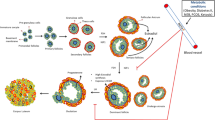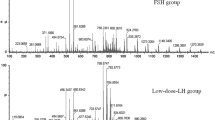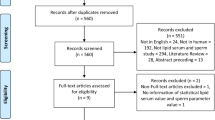Abstract
Phospholipids, predominantly phosphoglycerides, have long been recognized as a major component of cell and organellar membranes where they form the phospholipid bilayer. The phospholipid bilayer creates the permeability barrier of all cells and serves as a matrix for a large number of proteins involved in diverse cellular functions including cellular communication, replication, trafficking etc. Although devoid of any catalytic activity, the phospholipids are in a constant state of flux within the membrane and play a significant role in regulating biochemical signaling and the activity of the proteins associated with the membranes (Dowhan, 1997).
Access this chapter
Tax calculation will be finalised at checkout
Purchases are for personal use only
Preview
Unable to display preview. Download preview PDF.
Similar content being viewed by others
References
ACOG. Hypertension in pregnancy. In American College of Obstetricians and Gynecologists, Washington DC, Technical Bulletin No. 219 (1996).
ACS. Cancer Facts and Figures 2002 and Imaging Breast Health Information. American Cancer Society (2002).
Albala JS. Array-based proteomics: the latest chip challenge. Expert Rev Mol Diagn 1: 145–152 (2001).
Alizadeh AA, Ross DT, Perou CM, van de Rijn M. Towards a novel classification of human malignancies based on gene expression patterns. J Pathol 195: 41–52 (2001).
Baker DL, Morrison P, Miller B et al. Plasma lysophosphatidic acid concentration and ovarian cancer. J Am Med Assoc 287: 3081–3082 (2002).
Ballweg ML. The Endometriosis Sourcebook. Contemporary Books, Lincolnwood (1995).
Balsinde J, Balboa MA, Insel PA, Dennis EA. Regulation and inhibition of phospholipase A2. Ann Rev Pharmacol Toxicol 39: 175–189 (1999).
Bandoh K, Aoki J, Taira A et al. Lysophosphatidic acid (LPA) receptors of the EDG family are differentially activated by LPA species. Structure-activity relationship of cloned LPA receptors. FEBS Lett 478: 159–165 (2000).
Bedaiwy MA, Falcone T, Sharma RK et al. Prediction of endometriosis with serum and peritoneal fluid markers: a prospective controlled trial. Hum Reprod 17: 426–431 (2002).
Berg CJ, Atrash HK, Koonin LM, Tucker M. Pregnancy-related mortality in the United States, 1987–1990. Obstet Gynecol 88:161–167 (1996).
Brosens I. Diagnosis of endometriosis. Semin Reprod Endocrinol 15: 229–233 (1997).
Brouwers JF, Vernooij EA, Tielens AG, van Golde LM. Rapid separation and identification of phosphatidylethanolamine molecular species. J Lipid Res 40: 164–169 (1999).
Budnik LT, Mukhopadhyay AK. Lysophosphatidic acid and its role in reproduction. Biol Reprod 66: 859–865 (2002).
Bussolino F, Camussi G. Platelet-activating factor produced by endothelial cells. A molecule with autocrine and paracrine properties. Eur J Biochem 229: 327–337 (1995).
Cheong YC, Shelton JB, Laird M et al. IL-1, IL-6 and TNF-alpha concentrations in the peritoneal fluid of women with pelvic adhesions. Hum Reprod 17: 69–75 (2002).
Chin TY, Chueh SH. Sphingosylphosphorylcholine stimulates mitogen-activated protein kinase via a Ca2+-dependent pathway. Am J Physiol 275: C1255–1263 (1998).
Chun J, Goetzl EJ, Hla T et al. International Union of Pharmacology. XXXIV. Lysophospholipid receptor nomenclature. Pharmacol Rev 54: 265–269 (2002).
Contos JJ, Ishii I, Chun J. Lysophosphatidic acid receptors. Mol Pharmacol 58: 1188–1196 (2000).
Creer MH, Gross RW. Separation of isomeric lysophospholipids by reverse phase HPLC. Lipids 20: 922–928 (1985).
Cunnick JM, Dorsey JF, Munoz-Antonia T et al. Requirement of SHP2 binding to disassociated binder-1 for mitogen-activated protein kinase activation in response to lysophosphatidic acid and epidermal growth factor. J Biol Chem 275: 13842–13848 (2000).
Dowhan W. Molecular basis for membrane phospholipid diversity: why are there so many lipids? Ann Rev Biochem 66: 199–232 (1997).
Eder AM, Sasagawa T, Mao M et al. Constitutive and lysophosphatidic acid (LPA)-induced LPA production: role of phospholipase D and phospholipase A2. Clin Cancer Res 6: 2482–2491 (2000).
Edsall LC, Cuvillier O, Twitty S et al. Sphingosine kinase expression regulates apoptosis and caspase activation in PC 12 cells. J Neurochem 76: 1573–1584 (2001).
Endresen MJ, Lorentzen B, Henriksen T. Increased lipolytic activity of sera from preeclamptic women due to the presence of a lysophospholipase. Stand J Clin Lab Invest 53: 733–739 (1993).
Erickson JR, Espinal G, Mills GB. Analysis of the EDG2 receptor based on the structure/activity relationship of LPA. Ann NY Acad Sci 905: 279–281 (2000).
Erickson JR, Hasegawa Y, Fang X et al. Lysophosphatidic acid and ovarian cancer: a paradigm for tumorogenesis and patient management. Prostaglandins Other Lipid Mediat 64:63–81 (2001).
Eskenazi B, Warner M, Bonsignore L et al. Validation study of nonsurgical diagnosis of endometriosis. Fertil Steril 76: 929–935 (2001).
Eskenazi B, Warner ML. Epidemiology of endometriosis. Obstet Gynecol Clin North Am 24: 235–258 (1997).
Fang X, Yu S, LaPushin R et al. Lysophosphatidic acid prevents apoptosis in fibroblasts via G(i)-protein-mediated activation of mitogen-activated protein kinase. Biochem J 352: 135–143 (2000).
Farooqui AA, Horrocks LA, Farooqui T. Deacylation and reacylation of neural membrane glycerophospholipids. J Mol Neurosci 14: 123–135 (2000).
Fukushima N, Ishii I, Contos JJ et al. Lysophospholipid receptors. Ann Rev Pharmacol Toxicol 41: 507–534 (2001).
Gaits F, Fourcade O, Le Balle F et al. Lysophosphatidic acid as a phospholipid mediator: pathways of synthesis. FEBS Lett 410: 54–58 (1997).
Genbacev O, DiFederico E, McMaster M, Fisher SJ. Invasive cytotrophoblast apoptosis in pre-eclampsia. Hum Reprod 14: 59–66 (1999).
Gerbie AB, Merrill J A. Pathology of endometriosis. Clin Obstet Gynecol 31: 779–786 (1988).
Goetzl EL Pleiotypic mechanisms of cellular responses to biologically active lysophospholipids. Prostaglandins Other Lipid Mediat 64: 11–20 (2001).
Goetzl EJ, An S. Diversity of cellular receptors and functions for the lysophospholipid growth factors lysophosphatidic acid and sphingosine 1-phosphate. FASEB J 12: 1589–1598 (1998).
Goetzl EJ, Dolezalova H, Kong Y et al. Distinctive expression and functions of the type 4 endothelial differentiation gene-encoded G protein-coupled receptor for lysophosphatidic acid in ovarian cancer. Cancer Res 59: 5370–5375 (1999a).
Goetzl EJ, Dolezalova H, Kong Y, Zeng L. Dual mechanisms for lysophospholipid induction of proliferation of human breast carcinoma cells. Cancer Res 59: 4732–4737 (1999b).
Gratacos E. Lipid-mediated endothelial dysfunction: a common factor to preeclampsia and chronic vascular disease. Eur J Obstet Gynecol Reprod Biol 92: 63–66 (2000).
Hannun YA, Luberto C, Argraves KM. Enzymes of sphingolipid metabolism: from modular to integrative signaling. Biochemistry 40: 4893–4903 (2001).
Hemmings R, Miron P, Falcone T et al. Platelet-activating factor acetylhydrolase activity in peritoneal fluids of women with endometriosis. Obstet Gynecol 81: 276–279 (1993).
Herrlich A, Daub H, Knebel A et al. Ligand-independent activation of platelet-derived growth factor receptor is a necessary intermediate in lysophosphatidic, acid-stimulated mitogenic activity in L cells. Proc Natl Acad Sci USA 95: 8985–8990 (1998).
Hopper DW, Ragan SP, Hooks SB et al. Structure-activity relationships of lysophosphatidic acid: conformationally restricted backbone mimetics. J Med Chem 42: 963–970 (1999).
Imai A, Furui T, Tamaya T, Mills GB. A gonadotropin-releasing hormone-responsive phosphatase hydrolyses lysophosphatidic acid within the plasma membrane of ovarian cancer cells. J Clin Endocrinol Metab 85: 3370–3375 (2000).
Jalink K, Hengeveld T, Mulder S et al. Lysophosphatidic acid-induced Ca2+ mobilization in human A431 cells: structure-activity analysis. Biochem J 307: 609–616 (1995).
Jalink K, Hordijk PL, Moolenaar WH. Growth factor-like effects of lysophosphatidic acid, a novel lipid mediator. Biochim Biophys Acta 1198: 185–196 (1994).
Jasinska R, Zhang QX, Pilquil C et al. Lipid phosphate phosphohydrolase-1 degrades exogenous glycerolipid and sphingolipid phosphate esters. Biochem J 340: 677–686 (1999).
Jendryczko A, Drozdz M. Increased placental phospholipase A2 activities in pre-eclampsia. Zentralbl Gynakol 112: 889–891 (1990).
Jendryczko A, Tomala J, Drozdz M, Wloch S. Placental phospholipase A2 activities in preeclampsia. Ginekol Pol 60: 280–282 (1989).
Katz-Brull R, Seger D, Rivenson-Segal D et al. Metabolic markers of breast cancer: enhanced choline metabolism and reduced choline-ether-phospholipid synthesis. Cancer Res 62: 1966–1970 (2002).
Khan J, Bittner ML, Chen Y et al. DNA microarray technology: the anticipated impact on the study of human disease. Biochim Biophys Acta 1423: M17–28 (1999).
Klein J. Membrane breakdown in acute and chronic neurodegeneration: focus on choline-containing phospholipids. J Neural Transm 107: 1027–1063 (2000).
Kobayashi T, Gu F, Gruenberg J. Lipids, lipid domains and lipid-protein interactions in endocytic membrane traffic. Semin Cell Dev Biol 9: 517–526 (1998).
Koh JS, Lieberthal W, Heydrick S, Levine JS. Lysophosphatidic acid is a major serum noncytokine survival factor for murine macrophages which acts via the phosphatidylinositol 3-kinase signaling pathway. J Clin Invest 102: 716–727 (1998).
Koonin LM, Atrash HK, Rochat RW, Smith JC. Maternal mortality surveillance, United States, 1980–1985. Mor Mortal Wkly Rep CDC Surveill Summ 37: 19–29 (1988).
Kranenburg O, Moolenaar WH. Ras-MAP kinase signaling by lysophosphatidic acid and other G protein-coupled receptor agonists. Oncogene 20: 1540–1546 (2001).
Laffargue M, Raynal P, Yart A et al. An epidermal growth factor receptor/Gab 1 signaling pathway is required for activation of phosphoinositide 3-kinase by lysophosphatidic acid. J Biol Chem 274: 32835–32841 (1999).
le Balle F, Simon MF, Meijer S et al. Membrane sidedness of biosynthetic pathways involved in the production of lysophosphatidic acid. Adv Enzyme Reg 39: 275–284 (1999).
Lesnefsky EJ, Stoll MS, Minkler PE, Hoppel CL. Separation and quantitation of phospholipids and lysophospholipids by high-performance liquid chromatography. Anal Biochem 285:246–254 (2000).
Levade T, Auge N, Veldman RJ et al. Sphingolipid mediators in cardiovascular cell biology and pathology. Circ Res 89: 957–968 (2001).
Lim KH, Rice GE, de Groot CJ, Taylor RN. Plasma type II phospholipase A2 levels are elevated in severe preeclampsia. Am J Obstet Gynecol 172: 998–1002 (1995).
Lopez-Jaramillo P, Casas JP, Serrano N. Preeclampsia: from epidemiological observations to molecular mechanisms. Braz J Med Biol Res 34: 1227–1235 (2001).
Lu J, Xiao YJ, Baudhuin LM et al. Role of ether-linked lysophosphatidic acids in ovarian cancer cells. J Lipid Res 43: 463–476 (2002).
Lu PY, Ory SJ. Endometriosis: current management. Mayo Clin Proc 70: 453–463 (1995).
Lykidis A, Jackowski S. Regulation of mammalian cell membrane biosynthesis. Prog Nucleic Acid Res Mol Biol 65: 361–393 (2001).
Lynch KR, Hopper DW, Carlisle SJ et al. Structure/activity relationships in lysophosphatidic acid: the 2-hydroxyl moiety. Mol Pharmacol 52: 75–81 (1997).
Lynch KR, Macdonald TL. Structure activity relationships of lysophospholipid mediators. Prostaglandins Other Lipid Mediat 64: 33–45 (2001).
Ma YY, Wei SJ, Lin YC et al. PIK3CA as an oncogene in cervical cancer. Oncogene 19: 2739–2744 (2000).
Merchant TE, Meneses P, Gierke LW et al. P magnetic resonance phospholipid profiles of neoplastic human breast tissues. Br J Cancer 63: 693–698 (1991).
Mills GB, Eder A, Fang X et al. Critical role of lysophospholipids in the pathophysiology, diagnosis, and management of ovarian cancer. Cancer Treat Res 107: 259–283 (2002).
Mills GB, Lu Y, Fang X et al. The role of genetic abnormalities of PTEN and the phosphatidylinositol 3-kinase pathway in breast and ovarian tumorigenesis, prognosis, and therapy. Semin Oncol 28: 125–141 (2001).
Montrucchio G, Sapino A, Bussolati B et al. Potential angiogenic role of platelet-activating factor in human breast cancer. Am J Pathol 153: 1589–1596 (1998).
Moolenaar WH. Bioactive lysophospholipids and their G protein-coupled receptors. Exp Cell Res 253: 230–238 (1999).
Murphy AA. Clinical aspects of endometriosis. Ann NY Acad Sci 955: 1–10: discussion 34–16, 396–406 (2002).
Murphy AA, Santanam N, Morales AJ, Parthasarathy S. Lysophosphatidylcholine, a chemotactic factor for monocytes/T-lymphocytes is elevated in endometriosis. J Clin Endocrinol Metab 83: 2110–2113 (1998).
Norwitz ER, Repke JT. Preeclampsia prevention and management. J Soc Gynecol Investig 7: 21–36 (2000).
Older J. Leeches and laudanum: Grandmother and you: Historical highlights. In Endometriosis. Scribner’s, New York (1984).
Oliver DJ, Nikolau B, Wurtele ES. Functional genomics: high-throughput mRNA, protein, and metabolite analyses. Metab Eng 4: 98–106 (2002).
Pages C, Simon MF, Valet P, Saulnier-Blache JS. Lysophosphatidic acid synthesis and release. Prostaglandins Other Lipid Mediat 64: 1–10 (2001).
Panetti TS, Magnusson MK, Peyruchaud O et al. Modulation of cell interactions with extracellular matrix by lysophosphatidic acid and sphingosine 1-phosphate. Prostaglandins Other Lipid Mediat 64: 93–106 (2001).
Podo F. Tumour phospholipid metabolism. NMR Biomed 12: 413–439 (1999).
Pulkkinen MO, Poranen AK, Kivikoski Al, Nevalainen TJ. Elevated serum group II phospholipase A2 levels are associated with decreased blood flow velocity in the umbilical artery. Gynecol Obstet Invest 41: 93–95 (1996).
Pyne S, Pyne NJ. Sphingosine 1-phosphate signalling in mammalian cells. Biochem J 349: 385–402 (2000).
Ramey JW, Archer DF. Peritoneal fluid: its relevance to the development of endometriosis. EertilSteril 60: 1–14 (1993).
Riordan JR, Rommens JM, Kerem B et al. Identification of the cystic fibrosis gene: Cloning and characterization of complementary DNA. Science 245: 1066–1073 (1989).
Roberts JM. Endothelial dysfunction in preeclampsia. Semin Reprod Endocrinol 16: 5–15 (1998).
Roberts R, Sciorra VA, Morris AJ. Human type 2 phosphatide acid phosphohydrolases. Substrate specificity of the type 2a, 2b, and 2c enzymes and cell surface activity of the 2a isoform.J Biol Chem 273: 22059–22067 (1998).
Rochat RW, Koonin LM, Atrash HK, Jewett JF. Maternal mortality in the United States: eport from the Maternal Mortality Collaborative. Obstet Gynecol 72: 91–97 (1988).
Rowland BL, Vermillion ST, Roudebush WE. Elevated circulating concentrations of platelet activating factor in preeclampsia. Am J Obstet Gynecol 183: 930–932 (2000).
Rui L, Archer SF, Argetsinger LS, Carter-Su C. Platelet-derived growth factor and lysophosphatidic acid inhibit growth hormone binding and signaling via a protein kinase C-dependent pathway. J Biol Chem 275: 2885–2892 (2000).
Sakata-Kaneko S, Wakatsuki Y, Usui T et al. Lysophosphatidylcholine upregulates CD40 ligand expression in newly activated human CD4+ T cells. FEBS Lett 433: 161–165 (1998).
Salas SP. What causes pre-eclampsia? Baillieres Best Pract Res Clin Obstet Gynaecol 13: 41–57 (1999).
Sano M, Morishita T, Nozaki M et al. Elevation of the phospholipase A2 activity in peritoneal fluid cells from women with endometriosis. Fertil Steril 61: 657–662 (1994).
Sasagawa T, Okita M, Murakami J et al. Abnormal serum lysophospholipids in multiple myeloma patients. Lipids 34: 17–21 (1999).
Sato TN. A new role of lipid receptors in vascular and cardiac morphogenesis. J Clin Invest 106: 939–940 (2000).
Schulte KM, Beyer A, Kohrer K et al. Lysophosphatidic acid, a novel lipid growth factor for human thyroid cells: Over-expression of the high-affinity receptor edg4 in differentiated thyroid cancer. Int J Cancer 92: 249–256 (2001).
Shen Z, Wu M, Elson P et al. Fatty acid composition of lysophosphatidic acid and lysophosphatidylinositol in plasma from patients with ovarian cancer and other gynecological diseases. Gynecol Oncol 83: 25–30 (2001).
Siess W. Athero- and thrombogenic actions of lysophosphatidic acid and sphingosine-1-phosphate. Biochim Biophys Acta 1582: 204–215 (2002).
Siess W, Zangl KJ, Essler M et al. Lysophosphatidic acid mediates the rapid activation of platelets and endothelial cells by mildly oxidized low density lipoprotein and accumulates in human atherosclerotic lesions. Proc Natl Acad Sci USA 96: 6931–6936 (1999).
Six DA, Dennis EA. The expanding superfamily of phospholipase A(2) enzymes: Classification and characterization. Biochim Biophys Acta 1488: 1–19 (2000).
Sliva D, Mason R, Xiao H, English D. Enhancement of the migration of metastatic human breast cancer cells by phosphatide acid. Biochem Biophys Res Comm 268: 471–479 (2000).
Spiegel S, Merrill AH. Sphingolipid metabolism and cell growth regulation. FASEB J 10: 1388–1397 (1996).
Stemmer SM. Current progress in early pregnancy investigation. Early Pregnancy 5: 4–8 (2001).
Subramanian VS, Goyal J, Miwa M et al. Role of lecithin-cholesterol acyltransferase in the metabolism of oxidized phospholipids in plasma: studies with platelet-activating factor-acetyl hydrolase-deficient plasma. Biochim Biophys Acta 1439: 95–109 (1999).
Sullentrop F, Moka D, Neubauer S et al. 31P NMR spectroscopy of blood plasma: determination and quantification of phospholipid classes in patients with renal cell carcinoma. NMR Biomed 15: 60–68 (2002).
Templin MF, Stoll D, Schrenk M et al. Protein microarray technology. Trends Biotechnol 20: 160–166 (2002).
Tigyi G. Physiological responses to lysophosphatidic acid and related glycero-phospholipids. Prostaglandins Other Lipid Mediat 64: 47–62 (2001).
Tokumura A, Yamano S, Aono T, Fukuzawa K. Lysophosphatidic acids produced by lysophospholipase D in mammalian serum and body fluid. Ann NY Acad Sci 905: 347–350 (2000).
Vinatier D, Orazi G, Cosson M, Dufour P. Theories of endometriosis. Eur J Obstet Gynecol ReprodBiol 96: 21–34 (2001).
Walker JJ. Pre-eclampsia. Lancet 356: 1260–1265 (2000).
Wang A, Dennis EA. Mammalian lysophospholipases. Biochim Biophys Acta 1439: 1–16 (1999).
Wellbery C. Diagnosis and treatment of endometriosis. Am Fam Physician 60: 1753–1762, 1767–1758 (1999).
WHO. Geographic variation in the incidence of hypertension in pregnancy. World Health Organization international collaborative study of hypertensive disorders of pregnancy. Am J Obstet Gynecol 158: 80–83 (1988).
Xia P, Gamble JR, Wang L et al. An oncogenic role of sphingosine kinase. Curr Biol 10: 1527–1530 (2000).
Xiao Y, Chen Y, Kennedy AW et al. Evaluation of plasma lysophospholipids for diagnostic significance using electrospray ionization mass spectrometry (ESI-MS) analyses. Ann NY Acad Sci 905: 242–259 (2000).
Xu Y, Fang XJ, Casey G, Mills GB. Lysophospholipids activate ovarian and breast cancer cells. Biochem J 309: 933–940 (1995a).
Xu Y, Gaudette DC, Boynton JD et al. Characterization of an ovarian cancer activating factor in ascites from ovarian cancer patients. Clin Cancer Res 1: 1223–1232 (1995b).
Xu Y, Shen Z, Wiper DW et al. Lysophosphatidic acid as a potential biomarker for ovarian and other gynecologic cancers. J Am Med Assoc 280: 719–723 (1998).
Xu Y, Xiao YJ, Baudhuin LM, Schwartz BM. The role and clinical applications of bioactive lysolipids in ovarian cancer. J Soc Gynecol Investig 8: 1–13 (2001).
Yamashita S, Ogawa M, Sakamoto K et al. Elevation of serum group II phospholipase A2 levels in patients with advanced cancer. Clin Chim Acta 228: 91–99 (1994a).
Yamashita S, Yamashita J, Ogawa M. Overexpression of group II phospholipase A2 in human breast cancer tissues is closely associated with their malignant potency. Br J Cancer 69: 1166–1170 (1994b).
Yamashita S, Yamashita J, Sakamoto K et al. Increased expression of membrane-associated phospholipase A2 shows malignant potential of human breast cancer cells. Cancer 71: 3058–3064 (1993).
Yoshida A, Ueda H. Neurobiology of the Edg2 lysophosphatidic acid receptor. Jpn J Pharmacol 87: 104–109 (2001).
Zhu K, Baudhuin LM, Hong G, et al. Sphingosylphosphorylcholine and lysophosphatidylcholine are ligands for the G protein-coupled receptor GPR4. J Biol Chem 276: 41325–41335 (2001).
Author information
Authors and Affiliations
Editor information
Editors and Affiliations
Rights and permissions
Copyright information
© 2003 Springer Science+Business Media New York
About this chapter
Cite this chapter
Chaudhary, J., Compton, T., Parrott, J.A. (2003). Bioactive Lipids in Reproductive Diseases. In: Harrigan, G.G., Goodacre, R. (eds) Metabolic Profiling: Its Role in Biomarker Discovery and Gene Function Analysis. Springer, Boston, MA. https://doi.org/10.1007/978-1-4615-0333-0_12
Download citation
DOI: https://doi.org/10.1007/978-1-4615-0333-0_12
Publisher Name: Springer, Boston, MA
Print ISBN: 978-1-4613-5025-5
Online ISBN: 978-1-4615-0333-0
eBook Packages: Springer Book Archive




